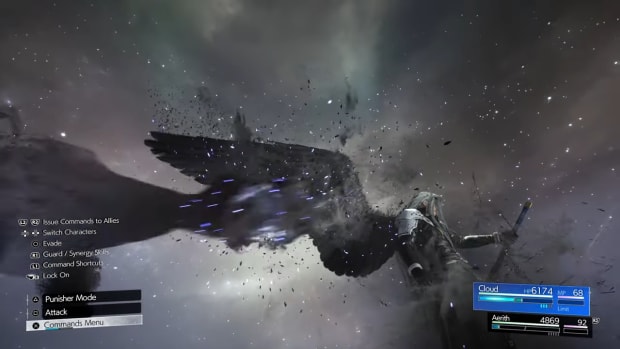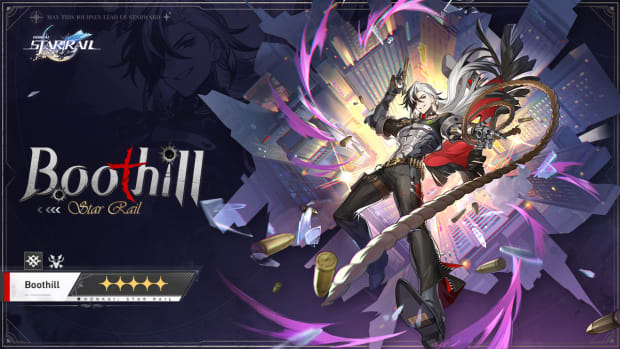Final Fantasy 16 review: an incredible action game that is compromised by shallow RPG mechanics
Final Fantasy is a series under constant reinvention, but there are familiar traits each game carries over. Giant, ridable chickens (complete with their own fanfare). Magic crystals, screen-filling summons, and massive swords. An engineer called Cid. Final Fantasy 16 promises all of this while also redefining what it means to carry that name.
Chocobos (those giant chickens) still have their own musical jingle when you ride them, but it’s only a few seconds – a little tease. Oh, and everyone eats them now. The Chocobos. Like, with their mouths.

Chocobos still have their own jingle when you ride them, but everyone also eats them now.
Square Enix
You can tell this world is for adults because people say naughty words, there’s a bit of side boob, and everyone chows down on Chocobo stew like absolute savages. Cid is also here, but it’s his daughter, Mid (I swear that’s what she’s called), who’s the real talent. There are summons (called Eikons), but only the most recognizable ones.
Other FF-flavoured things are conspicuously absent. Is it really a Final Fantasy game if you don’t fight a little mole with a knife? What about a tiny cactus fella? Sorry, you’ll have to live with orcs, goblins, humans, and a bunch of quadrupeds instead. At least the developers throw in the odd behemoth, flan, and bomb to keep you satisfied. Eat your flan!
It sometimes feels as if it’s embarrassed of being a Final Fantasy game – except when one of the characters literally says – without winking at the camera, thankfully – “I shall be the final witness to your fantasy.”
Final Fantasy 16 is an uneven game. There were moments – like the Platinum Games-tinged Eikon fight against Titan – where I was convinced that this was one of the best things I’ve ever played, but for every section as good as that, there are hours of drudgery. If you don’t think MMO-style fetch quests are the pinnacle of game design, you’re probably going to feel the same way.
Anyway, I’m getting ahead of myself.
You play as a man called Clive (I swear), who wears more belts than any one person needs. At the start of the game, Clive is a young warrior charged with protecting his younger brother, a Dominant who controls the power of the Phoenix. He gives you a little taste of this power yourself, so you’re able to set your sword ablaze and throw fireballs, but many people in this world dislike magic users – it’s a bit like racism but in a world almost exclusively filled with white people.

Clive is a young warrior charged with protecting his younger brother who controls the power of the Phoenix.
Square Enix
Dominants, on the other hand, are often revered. Summons have always been powerful in Final Fantasy games, but here they’re medieval weapons of mass destruction. Simply priming – the act of becoming an Eikon – next to someone is enough to turn them into ash. They call it ‘priming’ – like a bomb – for a reason.
Events happen, as they tend to do, and there’s a time skip. Clive is all grown up and he’s working for a group of magic-wielding assassins called The Bastards, which is admittedly an excellent name. There’s a lot of courtly scheming between various factions and leaders who are battling for control of magic crystals that stave off a blight encroaching on the land, and you’re caught in the middle of all of this arcane climate change and familial skullduggery.
It starts off almost like bloody and bold Game of Thrones fanfiction, but that complexity is soon replaced by an existential threat to remind you that this is still a Final Fantasy game, and you’ve got a god to kill. Get to it.
The cast is what keeps you playing. Clive is almost like an inversion of other Final Fantasy protagonists. Cloud and Squall bottled their emotions up to appear cool on the surface and hide the fact that they were actually more complex deep down. Clive lays it all out. He shouts, screams, cries, and loves. He does it all unapologetically and comes out looking cool in the process. It’s refreshing to play as someone so human. The supporting cast is just as nuanced and you’ll find yourself becoming invested in the relationships that blossom. There are even a few cheeky kisses and a little heavy petting. The fan art is going to be off the chain.
Of course, combat is where you’ll be spending most of your time. It’s the best real-time combat system in any Final Fantasy game, but it’s hampered by a handful of frustrating design decisions. The first is that the hardest difficulty – which adds new challenges, equipment, and more – is locked behind New Game+, which means you have to beat the long-ass game once to play the way it’s meant to be played. The default difficulty is a cakewalk, which means there’s very little reason to engage with the nuances of the combat system.

Final Fantasy 16 has the best real-time combat system in the series, hampered by some bad design decisions.
Square Enix
It is nuanced! There are jump cancels, dodge cancels, counters, blocks, aerial juggles, and flashy combos. Some moves have a variant that triggers when you use them to block or dodge an attack, and there are even items that amp up certain combat abilities, such as a ring that imbues your precision dodge with fire and lets you go absolutely ham on the counter-attack – I’m never taking it off.
But some of these skills are abilities, and you can only use three Eikons and two abilities for each at any one time, for six special moves in total. Sure, you could be flashy and equip the dodge cancel skill, but here’s this other ability that literally deletes everything on the screen and basically acts as a “skip battle” button. Since they’re weighted the same and take up the same amount of space, why would you not just use that?
All of this could have been solved with a few more ability slots, or if the developers had assigned the ultimate abilities to their own slot, or if you had a separate moveset for when you fired your Limit Break. There’s one of the best combat systems in any game ever somewhere in here, but its edge is blunted by too much streamlining. This didn’t need to be the case! There are already items that work as assists for people who just want the story.
A lot of the combat depth is also buried under sub-standard RPG fluff that’s so shallow that it evaporates as soon as you look at it too hard. When you level up, you get incremental stat increases. You can buy new weapons and accessories to deal more damage and take more hits. Outside of that, there’s a skill unlock menu where you can buy and assign skills from each of the Eikons, but since you can only have six activated at any one time, you might as well just find the ones you like and stick with those. By the end of the game, I had an abundance of useless crafting materials – I already had the best equipment – money (still called gil, except for when people talk about it), and skill points, but nothing to spend them on.
This has a knock-on effect, too. It means none of the rewards you get from doing the sidequests are meaningful. There are dozens and dozens of these filler missions, and only around six sidequests with actual, tangible rewards in the entire game, and they’re clearly marked as such. If you want the crafting materials for a new sword, you just have to do the optional monster hunts. If you get the itch to explore, all you’ll find out there in the world are more crafting materials and gil. It also actively nudges you into avoiding ordinary battles, since the experience payouts for them are pitiful.
I finished every single sidequest and there was only one that didn’t follow the same rules as the rest, where I had to memorize some passages and recite them to an old geezer. The rest go like this: kill some creatures, speak to some people, hold X on an item for a bit, stuff some food in your pocket, take it to someone, and press X on them to give them the pocket food. This design even seeps into the main missions.
For every excellent main mission you do – and some of them are astounding, some of the best stuff in any Final Fantasy game – you’re punished with a couple of hours of boredom to pad the running time out.
Everything good comes with some kind of caveat. The combat is incredible, but some bizarre design decisions hold it back. The characters are complex, but the dull mission design gets in the way of the text. The world looks cool when traveling from place to place, but the towns you visit are all forgettable.
At least the story is meaningful, asking you what it means to carry all of the hopes and dreams of your friends and family through life – does that give us power, or is it a weakness?
Clive reminds me of the game itself. At one point, he takes someone else’s name. He carries it like a banner into battle. He wears the name with pride. He works toward building up an idea, rather than his own legend. Final Fantasy 16, on the other hand, tries to carry all of the baggage of the series and ends up buckling under the weight of expectation. It’s being pulled in two directions by its distinct personalities and comes out of the other end as a brilliant action game that’s compromised by shallow RPG mechanics.
Score: 7/10
- Story and narrative: 8/10
- Visuals: 8/10
- Audio and music: 8/10
- Mechanics and systems: 7/10
- Technical performance: 6/10
Version tested: PS5
Final Fantasy 16 technical breakdown
I love playing action games at 60fps as much as anyone, but trust me when I say this: play Final Fantasy 16 in Graphics Mode. The game’s Performance Mode is currently not fit for purpose, and the frame rate jumps all over the place, even when you’re exploring the world. Knocking it down to 30fps results in a much more stable experience, and the good frame pacing almost makes up for not being able to play at 60. Even then, the game still struggles to stick to 30fps consistently when you hit the final open area of the game, which is blanketed in a kind of fog that noticeably taxes the PS5.




